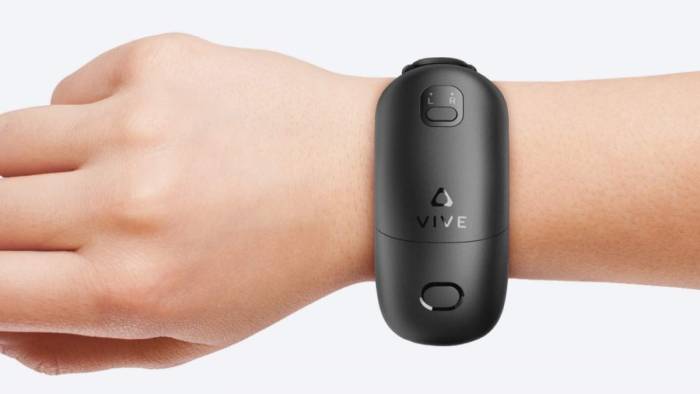HTC is releasing a new wrist-based controller for its Vive Focus 3 VR headset. The Vive Wrist Tracker is a wireless device that wraps around a user’s arm like a watch and tracks their orientation and location from hand to elbow. It’s meant to supplement the existing controllers on the business-oriented headset, especially for simulation and training scenarios where body posture is crucial. It’s part of a bigger set of new features HTC announced at CES, including a VR experience powered by 5G.
The Wrist Tracker looks a lot like HTC’s Vive Tracker device, which launched in 2017. It’s small, light, and specialised. It comes with a strap and a toggle that determines whether the tracker should be worn on the left or right arm, but unlike the multi-buttoned Vive Focus 3 controllers, it’s designed to connect to the headset wirelessly and communicate movement data without requiring the headset’s cameras to view it. (Inanimate items can also be attached to it.) Flaim recalls using it to guarantee that participants were carrying a virtual fire extinguisher in the correct position — something that a portable controller alone couldn’t always identify — and Taser maker Axon would reportedly incorporate it into the company’s VR training system.
The Wrist Tracker will be available in the first quarter of 2022 for $129. It’s not designed for customers, like the Vive Tracker and the $1,300 Vive Focus 3, and it’ll be most useful with experiences that are built particularly to take use of it. It is, however, one of HTC’s less exotic accessories, a category that includes a sophisticated lip tracking device. HTC will make a CAD file of the Wrist Tracker design available so that users can make their own accessories, such as custom docks or harnesses.
HTC has also announced the release of a “portable, private 5G experience” in collaboration with Lumen Technologies. It’s a Vive Focus 3 programme that offloads the majority of the data processing to a distant computer and transmits it over a private 5G network using Lumen. Since experiences can require a lot of computational power transmitted with minimal latency to headsets, mobile VR has been a long-standing potential use case for 5G networks — though it hasn’t been transformational in the space yet.
The business also revealed a charging case and attachment for charging multiple batteries at once at CES, aimed at location-based entertainment providers such as arcades that need to quickly swap out batteries for many headsets. The Vive Focus 3 promises to be more convenient, especially following a series of software changes last year. Location-based entertainment companies have been using wired HTC headsets for some time, but the Vive Focus 3 promises to be more useful.
- How to Check IIT GATE 2025 Results Online? Complete Guide - March 19, 2025
- Deadmau5 Sells Song Catalog for $55M to Launch New Music Venture - March 6, 2025
- Japanese Girl Group F5ve to Drop Debut Album ‘Sequence 01’ in May - March 6, 2025



